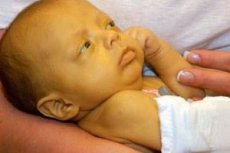Medical expert of the article
New publications
Causes and pathogenesis of galactosemia
Last reviewed: 23.04.2024

All iLive content is medically reviewed or fact checked to ensure as much factual accuracy as possible.
We have strict sourcing guidelines and only link to reputable media sites, academic research institutions and, whenever possible, medically peer reviewed studies. Note that the numbers in parentheses ([1], [2], etc.) are clickable links to these studies.
If you feel that any of our content is inaccurate, out-of-date, or otherwise questionable, please select it and press Ctrl + Enter.

Galactosemia type I
Autosomal recessive disease associated with mutations in the galactose-1-phosphate-uridyltransferase gene (GALT). The GALT gene is mapped to 9p13. To date, more than 180 different mutations, mostly represented by missense mutations, have been described. The most common mutations are Q188R and K285N mutations, together they make up more than 70% of all mutant alleles in European populations and cause the development of the classical form of galactosemia. The GALT gene also describes a large number of both intra- intron and intra- eccentric nucleotide substitutions whose presence alone or in various combinations with mutant alleles may influence the residual activity of the enzyme. One of the most studied intragenic replacements is the N314D mutation , the so-called Duarte variant. The presence of only N314D, even in the homozygous state, usually does not lead to the development of the disease, but changes the level of enzyme activity. Combinations of N314D / normal allele and N314D / Q188R account for 75 and 25% of the normal activity of the enzyme, respectively. The frequency of occurrence of the N314D allele among healthy individuals in different populations is, according to the literature, 6-8%.
Galactosemia, type II
The disease is inherited by autosomal recessive type. Mutations in the GK1 gene , mapped to 17q24, are described in most patients, including the P28T mutation found in gypsies.
Galactosemia, type III
The disease is inherited by autosomal recessive type. The gene of UDF-galactose-4-epimerase (GALE) is mapped on chromosome 1p36. Several mutations have been described, including the V94M mutation associated with severe disease.
Pathogenesis of galactosemia
Galactosemia type I
Galactose-1-phosphate-uridyltransferase, along with other enzymes involved in the metabolism of galactose - galactokinase and galactoepimerase, - transforms the galactose entering into the milk sugar into glucose. The consequence of the deficiency of galactose-1-phosphate-uridyltransferase is the accumulation of galactose and galactose-1-phosphate. These substances are toxic to the metabolism of many tissues - the brain, liver, kidneys, intestines. One of the manifestations of the toxicity syndrome is the inhibition of bactericidal activity of leukocytes, which contributes to the development of sepsis. Hyperchloremic acidosis can be caused by both intoxication accompanied by renal-tubular dysfunction, and it occurs again due to a chronic gastrointestinal disorder.
Galactitol and galactonate accumulate in tissues along with galactose-1-phosphate. The development of cataract in the deficiency of galactose-1-phosphate-uridil-transferase is due to the accumulation of galactolol. Insufficient effectiveness of the bezgalactose diet for galactosemia type I is explained by the mechanism of self-poisoning of patients, including the constant biosynthesis of galactose (from glucose) due to the formation of galactose-1-phosphate from uridine diphosphogalactose. Reducing the concentration of uridine-diphosphogalactose disrupts the synthesis of galactosides; perhaps this is the cause of neurological disorders.
Galactosemia, type II
When the enzyme is deficient, the stage of phosphorylation of galactose is disturbed. Cataract occurs as a result of the accumulation of galactatitol in the lens, which disrupts the structure of its fibers and leads to denaturation of the protein.
Galactosemia, type III
UDF-galactose-4-epimerase along with other enzymes - galactokinase and galactose-1-phosphaturidyl transferase - transforms the galactose entering into the milk sugar into glucose. This enzyme is bifunctional and also participates in the interconversion of UDF-N-acetylgalactosamine and UDP-N-acetylglucosamine, which are important constituents of polysaccharides and galactolipids. The inadequacy of the enzyme leads to the accumulation of UDP-galactose and galactose-1-phosphate. The pathogenesis of systemic failure of UDP-galactose-4-epimerase is similar to that of galactosemia, type I, but the phenomenon of toxicity is less pronounced.


 [
[